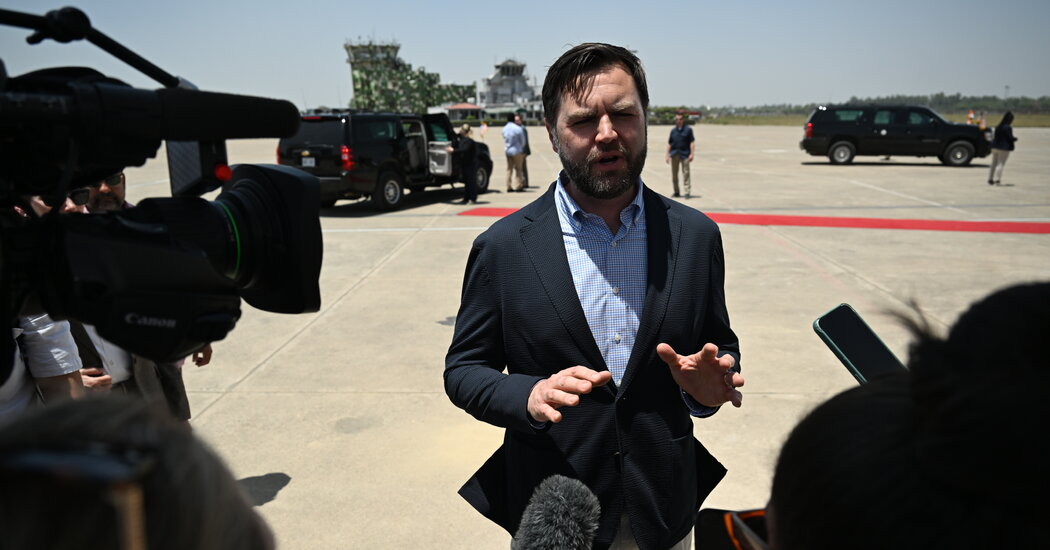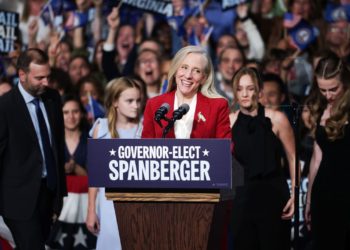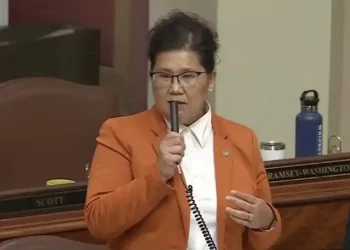Vice President JD Vance on Wednesday called on Ukraine to accept an American peace proposal that closely mirrors longstanding Russian demands, including a “freeze” of territorial lines in the three-year war, acceptance of the annexation of Crimea by Russia and a prohibition on Ukraine becoming part of the NATO alliance.
It was the first time a U.S. official had publicly laid out a cease-fire deal in such stark terms and the comments appeared designed to increase pressure on Ukraine, which has long refused to accept Russia’s claims on its lands, particularly in Crimea.
Mr. Vance, speaking during a trip to India, said the United States would “walk away” from the peace process if both Ukraine and Russia refused to accept the American terms. But President Volodymyr Zelensky of Ukraine was clearly the target.
“We’ve issued a very explicit proposal to both the Russians and the Ukrainians, and it’s time for them to either say yes or for the United States to walk away from this process,” Mr. Vance told reporters. “The only way to really stop the killing is for the armies to both put down their weapons, to freeze this thing and to get on with the business of actually building a better Russia and a better Ukraine.”
The vice president’s comments came just hours after Mr. Zelensky said his country will never accept Russia’s 2014 occupation of Crimea as legal, adding that doing so would violate Ukraine’s Constitution. He also said that Ukraine could not accept any prohibition against becoming part of NATO.
“There is nothing to talk about. This violates our Constitution. This is our territory, the territory of the people of Ukraine,” Mr. Zelensky told reporters in a news conference.
On Wednesday afternoon, Yulia Svyrydenko, the Ukrainian economy minister, also vowed that her country “will never recognize the occupation of Crimea.” Writing on X, the social media site, she said that “Ukraine is ready to negotiate — but not to surrender. There will be no agreement that hands Russia the stronger foundations it needs to regroup and return with greater violence.”
The threat by Mr. Vance to walk away from peace talks were similar to comments last week from Secretary of State Marco Rubio and from President Trump, who said in the Oval Office that if the two sides don’t agree quickly to a deal, “we’re just going to say, ‘You’re foolish, you’re fools, you’re horrible people, and we’re going to just take a pass.’”
On Wednesday, Mr. Vance told reporters in India that under the American proposal, “We’re going to freeze the territorial lines at some level close to where they are today.”
“The current lines, or somewhere close to them, is where you’re ultimately, I think, going to draw the new lines in the conflict,” he added. “Now, of course, that means the Ukrainians and the Russians are both going to have to give up some of the territory they currently own.”
The vice president did not say what territory Russia would have to give up.
A peace plan that would leave Russian forces deep inside eastern Ukraine would be welcome news in Moscow, where President Vladimir V. Putin has said for almost year that he would accept a cease-fire in which Ukraine withdraws troops from the four regions that Moscow has claimed as its own and drop its aspirations to join NATO.
Russia currently occupies 18.7 percent of Ukraine, according to DeepState, an online research group with ties to the Ukrainian army.
A freeze would essentially force Ukraine to effectively surrender huge swaths of land to Russia and would violate the principles of self-determination and borders that has animated the United States and European nations to support Ukraine since Russia’s invasion.
A Kremlin spokesman on Wednesday welcomed Mr. Vance’s remarks.
“The United States is continuing its mediation efforts, and we certainly welcome those efforts,” Dmitri S. Peskov, the spokesman, said. “Our interactions are ongoing but, to be sure, there is a lot of nuances around the peace settlement that need to be discussed.”
The aggressive push for a deal by Mr. Trump’s administration is a blow to European leaders, who have spent the last several weeks attempting to support Ukraine by brokering peace talks. The first effort convened last week in Paris and another session was set to start on Wednesday in London before Mr. Rubio announced on Tuesday night that he would no longer attend.
His decision to pull out prompted Britain’s foreign secretary, David Lammy, to decide that he, too, would not attend — though Mr. Lammy met separately with Ukraine’s foreign minister in London.
Lower-level diplomats from Britain, France, Germany, Ukraine, and the United States still gathered for technical talks. But the absence of the United States raised fears that Ukraine and Europe were being marginalized as the Trump administration seemed to be working primarily with Russia to formulate a cease-fire plan.
Those still meeting are expected to discuss details of the Trump administration’s proposed plan, which calls on Ukraine to recognize Russia’s annexation of Crimea — a move that much of the international community deemed illegal — and accept that its NATO aspirations will go unmet.
But expectations that the talks might produce progress toward a cease-fire had plummeted after Wednesday’s developments, which served to push European diplomats to the sidelines of the discussions between the United States and Russia.
Andriy Yermak, the Ukrainian president’s chief of staff, arrived in London Wednesday morning for the scaled-back talks along with his country’s ministers of defense and foreign affairs.
“Despite everything,” he wrote on X, the social media platform, after arriving, “we continue working for peace.”
Even before his comments Tuesday, Mr. Zelensky had conveyed his opposition to the American demands in a conversation with the Secretary General of NATO, Mark Rutte, according to an official familiar with the conversation. Mr. Zelensky laid out his positions on Crimea and NATO, the official said, and Mr. Rutte later called Mr. Trump and conveyed Mr. Zelensky’s answer.
A British official said the decision to scale back the meeting was made during a call between Mr. Rubio and Mr. Lammy, with the two men concluding that further technical talks were necessary before the foreign ministers met again. But Mr. Rubio’s decision to cancel clearly caught the British off guard, according to a second official who said Mr. Lammy had fully expected the secretary of state in London on Wednesday.
Instead of participating in a larger meeting, Mr. Lammy met one-on-one with the Ukrainian foreign minister, Andrii Sybiha, while the British defense secretary, John Healey, met his Ukrainian counterpart, Rustem Umerov, according to the British official. Mr. Lammy also dropped in on a lunch that included senior national security advisers from Britain, France, and Germany, as well as the Ukrainian delegation and General Kellogg.
Mr. Peskov on Wednesday told Russian news agencies that the London meeting fell through because of an apparent lack of progress in the negotiations before that.
“As far as we understand, they did not manage to move closer on some of the issues, that’s why that meeting did not take place,” he said.
Ségolène Le Stradic contributed reporting from Paris. Steven Erlanger contributed from Berlin. Nataliya Vasilyeva contributed from Istanbul.
Michael D. Shear is a White House correspondent for The Times. He has reported on politics for more than 30 years.
Mark Landler is the London bureau chief of The Times, covering the United Kingdom, as well as American foreign policy in Europe, Asia and the Middle East. He has been a journalist for more than three decades.
The post Vance Outlines U.S. Plan for Ukraine That Sharply Favors Russia appeared first on New York Times.




